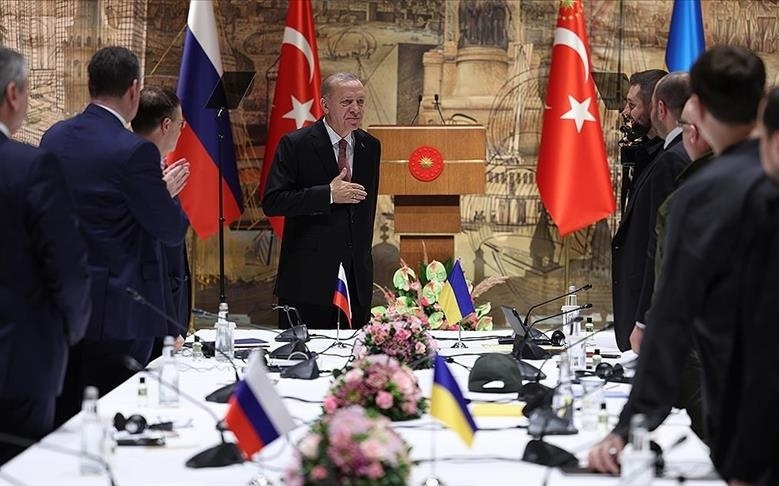Turkish President Recep Tayyip Erdoğan greets Ukrainian and Russian negotiators, Istanbul, Turkey, March 29, 2022 (Anadolu)
Documents obtained by The New York Times establish how Russia’s demands prevented talks in spring 2022 from ending Vladimir Putin’s invasion of Ukraine.
The documents were provided by Ukrainian, Russian and European sources, and confirmed as authentic by participants in the talks and other people close to them. Among them are draft treaties dated March 17 and April 15, 2022.
They are complemented by interviews with “more than a dozen Ukrainian, Russian, and Western current and former officials and others close to the talks”. Among them are three members of Ukraine’s negotiating team.
One Ukrainian negotiator, Oleksandr Chalyi, said, “We managed to find a very real compromise. We were very close in the middle of April, in the end of April, to finalize our war with some peaceful settlement.”
So why was there no conclusion to stop Russia’s invasion, then two months old, and its war crimes?
March: The Initial Phase
The talks began in Belarus on February 28, 2022, only four days after the Russia had launched their unsuccessful attempt for Kyiv’s quick capitulation and the fall of the Zelenskiy Government.
The Russian negotiators seemed to have little sense of that immediate failure. When the Ukrainians noted that Moscow already had 3,000 troops killed in action, Vladimir Putin’s lead negotiator Vladimir Medinsky was surprised. Russia’s senior military official Aleksandr Fomin insisted, “No, we only have 80 soldiers [killed].”
Ukraine conceded that it would be a “permanently neutral state” never joining NATO or allowing foreign forces to be based on its soil. But the Russians wanted more.
In the March 17 draft, Moscow demanded that Ukraine give up all of the Donbas — the Donetsk and Luhansk regions — in the east of the country. Kyiv had to recognize that Crimea, seized by Putin in 2014, was legally part of Russia. There would be strict limits on the size of the Ukrainian armed forces, including the number of tanks, artillery batteries, warships, and combat aircraft. Ukraine’s national identity would be eroded through measures such as a ban on naming places after Ukrainian independence fighters.
A week later, Poland’s President Andrzej Duda held up the text to NATO leaders in Brussels and asked, “Which of you would sign it?” Not a single hand was raised.
April: The Second Phase
By the start of April, Russia had been defeated throughout northern Ukraine. Its troops were forced to withdraw, leaving behind slain civilians in mass killings such as in the Kyiv suburb of Bucha.
Even with the revelation of the war crimes, the Ukrainians continued the talks, now being held in Istanbul, Turkey. Ukraine President Volodymyr Zelensky, visiting Bucha on April 4, confirmed the pngoing discussions.
With each setback, Putin “reduced his demands”, said one of the Ukrainian negotiators. Russia shifted focus from territorial demands to Ukraine’s proposal of neutrality and security guarantees.
In the two-page Istanbul Communiqué, Kyiv proposed that the status of Crimea would decided over 10 to 15 years, with a pledge not to try to retake the peninsula by force. Zelensky and Putin would meet in person to complete a peace treaty, including how much Ukrainian territory Russia would continue to occupy.
Ukraine also wanted the assurance of possible guarantor states such as the UK, China, Russia, the US, France, Turkey, Germany, Canada, Italy, Poland, and Israel.
The Guarantor States and Ukraine agree that in the event of aggression, any armed attack on Ukraine or any military operation against Ukraine, each of the Guarantor States, after urgent and immediate consultations between them…will provide … assistance to Ukraine, as a permanently neutral state under attack.
The Kremlin’s Unacceptable Demands
On April 15, the Russian negotiators sent a 17-page draft treaty to Putin.
And there the proposed agreement unraveled. Three days earlier, Putin indicated that he would make renewed demands. He promised that Russia would achieve all of its “noble” aims in Ukraine through military action. As for the talks, “we have again returned to a dead-end situation for us”.
Now the Russians demanded that the firing range of Ukraine’s missiles be limited to 25 miles, rather than Kyiv’s 174 miles. The army would have no more than 85,000 personnel, rather than 250,000, and 342 tanks rather than 800. They insisted that Ukraine repeal laws related to language and national identity, and pull back its troops as part of a cease-fire.
Most importantly, Putin’s officials inserted a clause saying that all guarantor states — including Russia — had to approve any response if Ukraine were attacked. Moscow could invade Ukraine and then veto any military intervention to defend against the aggression.
Ukraine’s lead negotiator David Arakhamia noted that Kyiv could not give way to the ultimatum: “There is no, and there was no, trust in the Russians that they would do it. That could only be done if there were security guarantees.”
Signing an agreement without effective guarantees would have left Ukraine vulnerable to a second incursion, he added: “They would have come in more prepared, because they came in, in fact, unprepared for such resistance.”
The Ukrainians saw no way forward. One said, “We had no interest in continuing the talks.”
On May 2, Oleksii Danilov, the chair of the Ukrainian National Security and Defense Council, closed the door for good: “A treaty with Russia is impossible — only capitulation can be accepted.”

